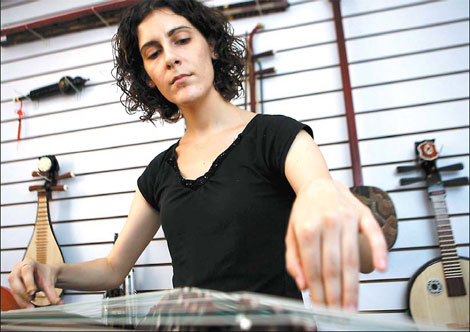
Tara Mahoney shows great enthusiasm in playing guzheng, a traditional stringed instrument. Huo Yan
Tara Mahoney can't remember the number of times she has cycled through Beijing for her music lessons. In the capital's hot and humid summer, she carries on her back a 1.5-m long case with a guzheng, a traditional stringed instrument.
This is the second year she has been studying the guzheng at Minyue Tang, an 80-sq-m classroom at the Beijing Working People's Culture Palace near the Forbidden City.
"It's very tranquil, simple and unsophisticated without the buzz of locusts and people's noise," Mahoney says. "It's such a great place to learn traditional Chinese instruments."
Mahoney had no idea about Chinese instruments until 2005, when the 24-year-old surfed the Net in her dorm at Ohio State University. She was attracted to a Chinese instrument, even though she couldn't hear what it sounded like.
After she graduated, she came to China to learn Chinese and touched the instrument for the first time in a department store. "Guzheng is bigger than I expected, and it gave swaying melodies and lingering sound," she says.
As an English teacher in the Beijing University of Aeronautics and Astronautics, Mahoney had enough free time to start learning Chinese and last July came across Minyue Tang while strolling through the Working People's Culture Palace.
"I was surprised to see a lot of Chinese instruments hanging on the wall. They stay there quietly, waiting for the proper players," she says.
Students who show a commitment can get free lessons at Minyue Tang. Many foreigners choose pipa, a four-stringed instrument. So did Mahoney, but she soon found it pretty hard to handle the spectacular finger work like rolls, slaps, pizzicato and harmonics.
Then she came across a website covering all Chinese instruments and providing sound clips. She browsed them one by one and found that the guzheng sounded the best.
However, Mahoney soon found that her playing gave her no artistic pleasure. "I focused on the fingertips and notes, and ignored the stories behind the songs, just like a singer singing without any emotion," she says.
Mahoney asked the teacher to tell her more about the background to each song and ancient instrument.
What impressed her most was the story of Yu Boya and Zhong Ziqi. Yu, a famous musician of the Spring and Autumn Period (770-476 BC), once played the seven-stringed guqin, a zither-like elegant instrument, in the countryside. One day, he was surprised to find a string snap, since it was believed to be a sign that a listener existed who truly understood what he was playing.
Yu asked his servant to search for the listener and found a man called Zhong Ziqi cutting firewood. He played a few more tunes and Zhong knew at once he was depicting the gorgeous mountains and the torrential river.
Yu embraced Zhong as a dear friend. Later, when he heard that Zhong had died, he broke his beloved guqin and vowed to never play it again.
Back to today and Mahoney thinks out loud: "I wonder where I can find someone who truly appreciates my playing."
Yang Le, founder of Minyue Tang, has learned from Mahoney about how to better teach foreign students. "It is hard for foreign students to achieve profound success due to cultural differences," Yang says.
David Thomas, a 64-year-old American, came to China on holiday last year and decided to learn erhu, a two-stringed fiddle, at Minyue Tang.
"He bought books to study by himself and reserved a spot in the class where he could ask me if he didn't understand something. He was very enthusiastic," says his coach, Jing Yanli.
Thomas invites Jing to his home every few days. After just 10 classes, he could play two medium-level songs.
"We want to help foreign students better understand China's traditional music philosophy," Yang says.
(China Daily 08/29/2008 page19)